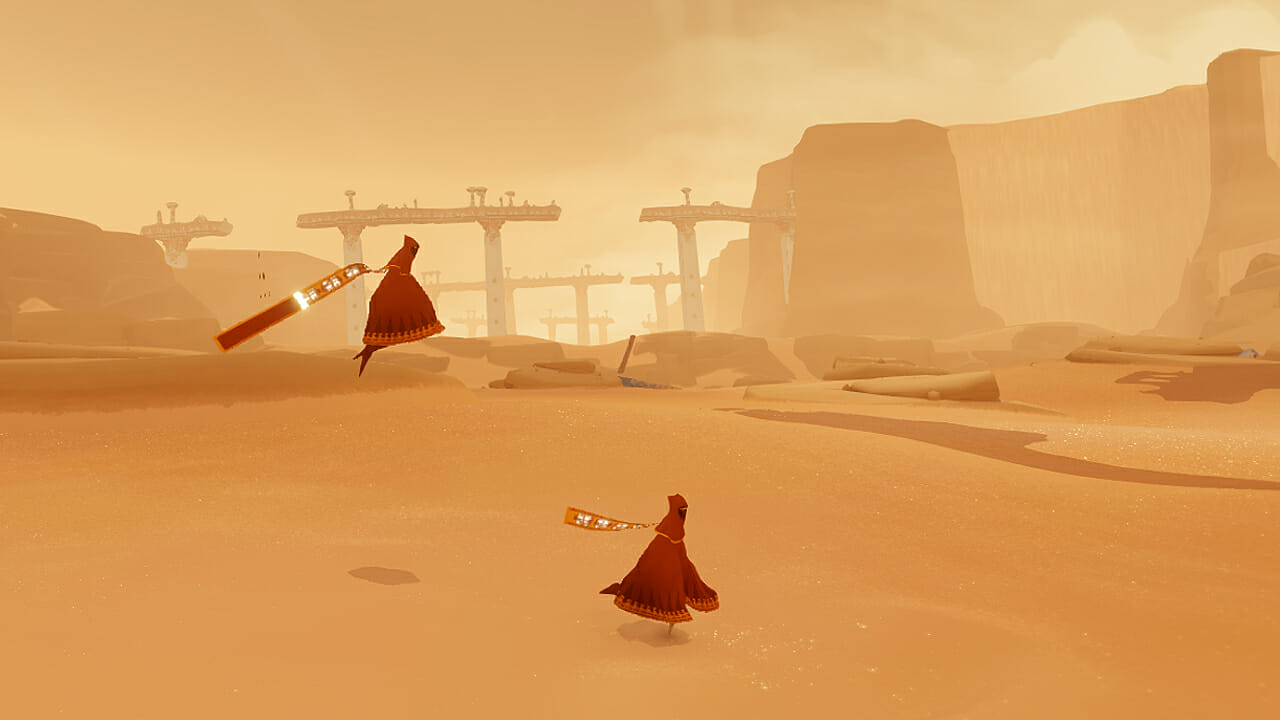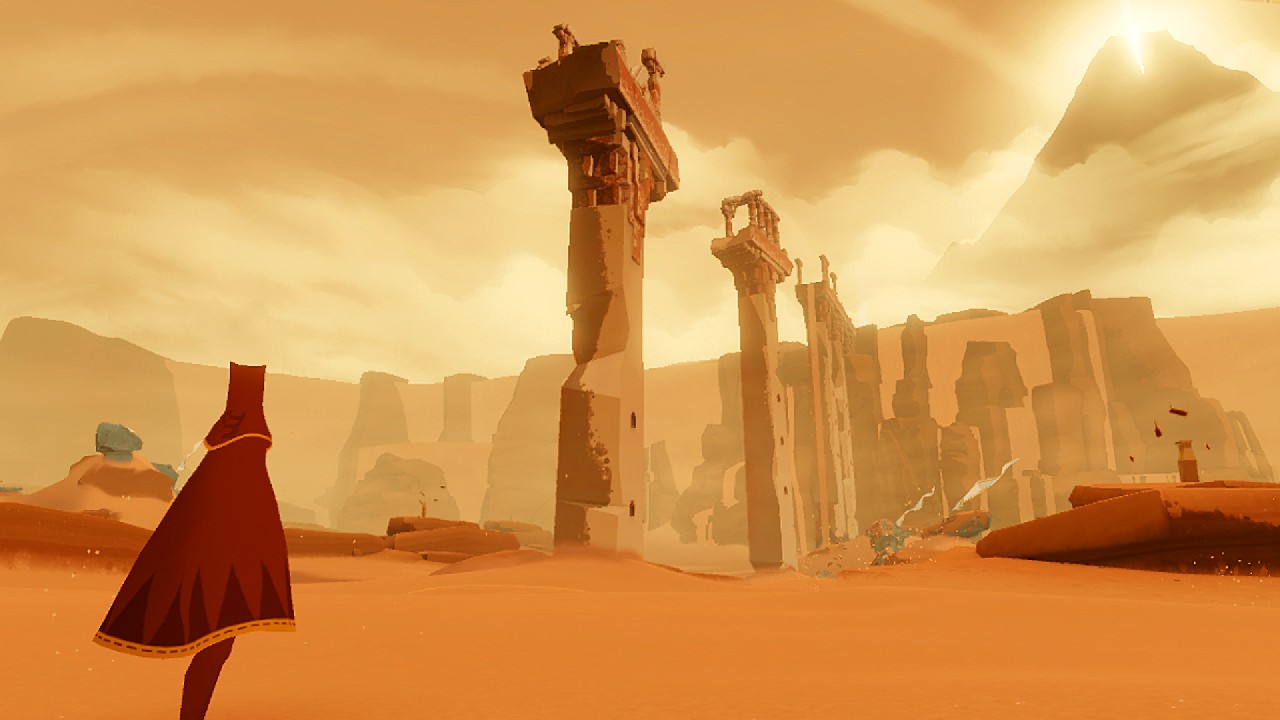
Thatgamecompany presents an abstract take on the hero’s journey.
I’ve never really gone on an adventure. Road trips don’t count, even with a stop at South of the Border. I did hang out in a desert once but I had a guide, a tour bus and a dozen other tourists at my back. The closest I’ve gotten to a quest is the time I went to five record stores in a day looking for a specific Fall album. My real life is supremely deprived of mythic glory.
I’m sure that’s a big part of why I play videogames. From Adventure to Mass Effect 3, games have pumped small doses of heroism into my sedentary life since I was five. Between that and the constant Joe Campbell parroting found in post Star Wars pop culture, I’ve lived through countless takes on the hero’s journey, all gliding together into one long uninterrupted fabric of high adventure. With a controller in my hand I am Link and I am Ramza and I am Fred McGriff in a fantasy world where the 1994 strike never happened (don’t tell me baseball isn’t an adventure). All different but all the same.
Journey strips that pattern down to its barest essentials. Thatgamecompany’s follow-up to 2009’s sublime Flower focuses like a laser on the most basic tenets of the hero’s journey, jettisoning the exposition and explicit character development expected from modern-day adventure games. Other than a wordless shout my red-robed hero is silent, largely without personality or history outside of what I create myself. His or her only goal is to reach the mountain that blazes just over the horizon, avoiding the typical videogame violence on what might be some sort of religious pilgrimage. My only goal is to enjoy the trip.
Journey paints in broad strokes, dealing in atmosphere and mystery and avoiding specifics. The ancient ruins of Journey’s desert are covered in indecipherable hieroglyphs, vast and trunkless legs of stone that I explore because I can and not because the game makes me. The darkness of its underground caverns shrouds me as I try to avoid the unknowable monsters that ominously fly above. I’m blasted by snow and powerful gusts as I make my last push up the frozen mountain face. Save points are sparse temples revived by my song, as angelic figures appear and animated hieroglyphs memorialize my adventures. There are no treasure chests, no friendly townspeople to chat with, just the peak looming ahead and the dangers of nature on the way.
I don’t just stroll through Journey, though. My hero wears a red scarf that grants the ability to fly. The length of the scarf defines how long I can stay aloft, and special icons hidden throughout the world increase its length. Little scraps of fabric can be found along the way, replenishing the scarf’s power and providing a boost that’s often needed to reach otherwise inaccessible perches. Eventually I free a flock of flying carpets from a desert castle, soaring among them with gleeful abandon.

When I first encounter the deadly sentinels that protect the later stages I take a direct hit and lose a significant stretch of my scarf. That hurts more than the loss of hit points ever could. Not only does it greatly reduce my flight time, it also cuts short what has developed into an integral extension of my hero. It’s like Samson losing his hair or Alex Trebek shaving his mustache.
Journey also features a form of two person online co-op, but in keeping with its enigmatic nature players can’t directly communicate with one another. Sadly I never encountered another player in the game proper, but during the beta last summer I ran into a number of fellow journeyers. We couldn’t speak or even learn each other’s names, but our characters could sing to each other and help replenish our scarves. It was also easy to just ignore the other person and carry on by myself. Perhaps playing through Journey together enhances its impact, but from my meager experiences it’s basically an inessential but unobtrusive footnote.
No game has ever been as succinctly named as Journey. That’s all this game is about, my forward momentum as I undertake this mysterious quest. I don’t know why I’m doing it, or what waits for me on the mountaintop, but I know it must be done. In reducing the journey to its most primordial form, Journey attains a universal power. Could its elemental nature also make it feel somewhat mundane, though? Is the primal allure of the journey itself enough to sustain a game without the characters and convoluted plots of a standard RPG or the constant accumulation of new and more powerful abilities?
The starkly minimalist Journey would risk becoming a bore if it wasn’t both gorgeous and very short. The environments are uniformly beautiful, with the deep oranges and reds of the desert giving way to brilliant blue skies and churning expanses of hostile grey snow. Even these destitute landscapes look as alive as the green hillsides of Flower. It takes barely two hours to reach the end, but it’s a smartly paced two hours, with nothing overstaying its welcome and new twists introduced at regular intervals. Instead of wilting under Journey’s asceticism, Thatgamecompany wrings as much as they can out of their self-imposed rules, ending with a surprisingly poignant conclusion that hits an emotional high the rest of their game doesn’t even attempt.
Journey is at once like many other videogames, but also thoroughly unique. It tears down the exterior of the standard adventure, but the basic framework is unmistakable. It may not be as thrilling as a more action-packed game, but its sedate thoughtfulness is enchanting. I doubt I’ll soon forget the time I spent with Journey, and that’s more then I can say about most games.
Journey was developed by Thatgamecompany and published by Sony. It is available for the PlayStation 3.
Garrett Martin is the videogame and comic book editor for Paste Magazine. He still doesn’t understand how Neal Schon fit into those pants back in the 70s. Twitter him, etc.